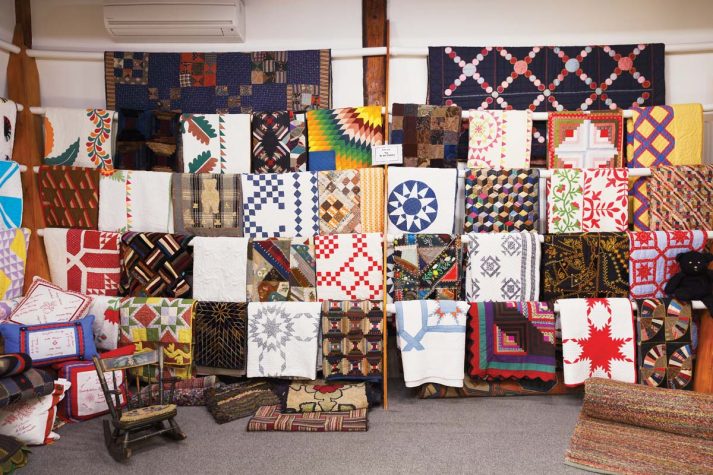Blanket Statements
Self-described “fabric junkie” Betsey Telford-Goodwin researches, restores, and sells antique quilts out of her historic mustard-colored home in York
Textiles, Betsey Telford-Goodwin believes, have always been her destiny. An English teacher by training, Telford-Goodwin discovered as an adult—years after she had begun selling quilts and vintage fabrics—that her great-grandfather ran many textile mills in New England. “I was adopted, so I had no idea,” she says as she sits at the large farmhouse table in her York home. “But some things are in your blood. I love textiles. I’m just a textile person. It’s as simple as that.”
Yet there’s nothing simple about Telford-Goodwin’s career or her specialized shop, Rocky Mountain Quilts. This unique showroom sells American quilts that were made before 1950, including dozens of stunning antique specimens created by Amish seamstresses, New England colonial housewives, and Mennonite farmers. Since getting her start selling quilts in Colorado, where she lived for 10 years, Telford-Goodwin has become an important figure in the fields of textile research and restoration. In the past two decades, she has lectured all over the world, from Japan to Europe.
On one memorable trip, she recalls speaking to a Japanese audience through a translator. “I was in a lecture hall bigger than my house,” she says. “I was nervous, and it was jammed. I had quilts hanging all the way around the walls. Every seat was taken. At one point, I looked down and I saw that everyone was sitting there with their eyes closed, and I just freaked out. I thought I was boring them to death.”
As it turns out, her words were having the opposite effect. “I learned later that in Japan people are taught that when something is being said that you want to remember, you close your eyes and focus,” she says, laughing.
When Telford-Goodwin isn’t traveling to lectures, museums, or antique shows, she spends her days running both her shop and restoration business, plus scouring markets for new finds.
Every cotton quilt she sells has been hand-washed and cleaned with organic soaps in her barn house bathtub. “They’re ready to go straight home,” she says as she picks up a blue-and-white quilt sewn with a geometric compass rose pattern. Next, she lays out a white quilt with a pattern of ivy sewn in green fabric, then takes down an Inuit quilt made of sealskin (these are just a few examples out of the over 550 she currently has in stock). However, Telford-Goodwin explains that not all of these quilts should be put on a bed. “While the vast majority of my quilts can be used on a bed, I would say 80 percent of my customers choose to hang them in their homes,” she says. “They are works of art.”
Although many of Telford-Goodwin’s quilts were originally intended to be practical objects, the decades (and sometimes centuries) have transformed them into something else entirely. They have become relics of another time, imbued with symbols and steeped in history. Most of these quilts were made by women long dead. These quilts, Telford-Goodwin says, help tell their stories.
Plus, she adds, nothing can brighten a room quite like a quilt. “A quilt does something that other pieces of art can’t do,” she explains. “You can look at an exquisite oil painting, but it doesn’t make you smile quite like a quilt does. It warms up the atmosphere emotionally.” In other words, a quilt, whether it’s hanging on a wall or lying on a bed, can help turn a house into a home.
Design tips for decorating with quilts
- Telford-Goodwin sells many of her quilts to musicians, who use them to help dampen sound in their practice rooms. “Quilts are wonderful for acoustics,” she says.
- If you plan to use a quilt as a statement piece, Telford-Goodwin has some suggestions: “Find your quilt first, and then have custom paint colors made from the colors in your quilt. A quilt will make a whole room, and colors are personal, so start with the quilt, then the colors, then do the rest of the room.”
- Keep your quilt away from direct sunlight. “It doesn’t matter if the quilt is antique or new, sunlight is never good for fabrics,” Telford-Goodwin notes. The two colors that won’t be changed by light, she says, are true indigo and turkey red.
- However, that doesn’t mean you can’t light your quilt. “Use LED lights, or hang it next to a window instead of across from one,” she says. North-facing windows can offer diffused sunlight that will be gentle on your quilt.


